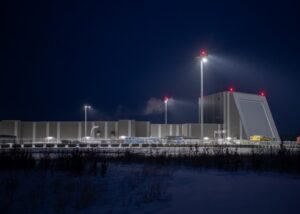HUNTSVILLE, Ala. – U.S. Northern Command (NORTHCOM) plans for the Long Range Discrimination Radar to be operational and connected to the larger missile defense operational architecture within months, Brig. Gen. Joseph Letorti, director of operations at NORTHCOM, said Wednesday.
“We are literally months away from being able to plug the long range discrimination radar, LRDR, in the missile defense operational architecture,” Letorti said here during the annual Space and Missile Defense Symposium.

He added that so far NORTHCOM is seeing positive results from LRDR tests discriminating missile threats.
LRDR seeks to help make the Ground-based Midcourse Defense (GMD) system Ground Based Interceptors (GBIs) more effective and lethal by better discriminating between long-range missile threat vehicles and decoys or non-lethal objects.
Letorti underscored LRDR’s power is not limited to daily ballistic missile defense (BMD) missions, but also supporting U.S. Space Command and space domain awareness missions. He said LRDR is not the only sensor that can apply to multiple missions.
“The multi-mission functionality and synergy that LRDR provides for space and BMD is a good start, but it isn’t the only sensor out there that has dual mission functionality. We need to look beyond those two specific mission sets if we really want to expand our domain awareness,” he said.
Letorti said the top priority of Gen. Glen VanHerck, commander of NORTHCOM, is domain awareness, “and we are seeing progress in this area.”
He argued the military needs to optimize its sensor network and look into certain sensors contributing to these kinds of overlapping mission areas.
“If a sensor like LRDR acquires a track that isn’t a ballistic missile or satellite, where does that data go? Should the radar drop it or could that data be passed to the architecture and increase awareness in the air domain? We need to explore the possibilities of future sensors contributing to the expanding domain awareness and hypersonic tracking.”
The Missile Defense Agency (MDA) announced construction and installation of radar arrays at LRDR at Clear Air Force Station, Alaska was completed last December (Defense Daily, Dec. 7, 2021).
LRDR was built by Lockheed Martin [LMT] at an estimated cost of $1.5 billion. It is an S-Band gallium nitride radar that is about 60 feet tall by 60 feet wide. MDA previously said once LRDR is fully operational it will be able to search and track multiple small objects at very long ranges simultaneously. This includes ballistic missiles, active and inactive satellite, spent rocket bodies and fragmentation debris.
When MDA announced the construction and installation was finished, the agency said the system was set to integrate into the GMD system and the Command and Control, Battle Management and Communications (C2BMC) during 2022 before moving on to operational acceptance by the Air Force in 2023.